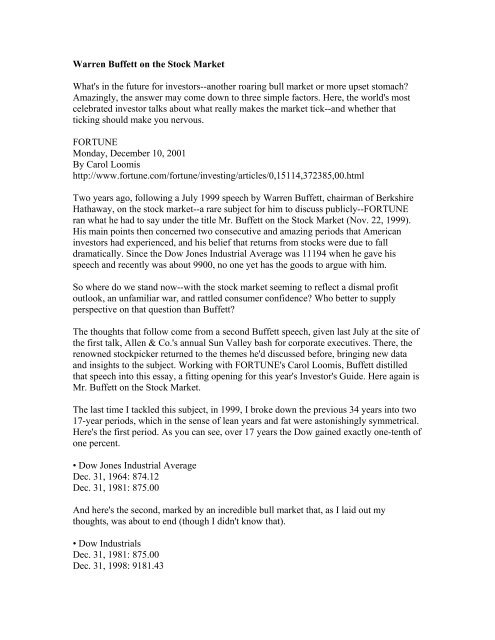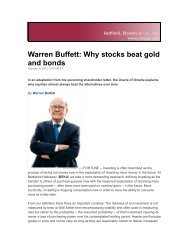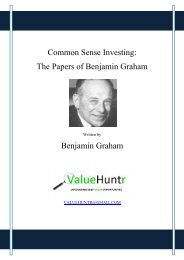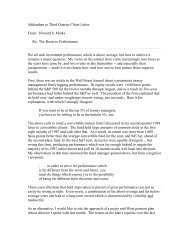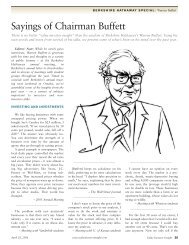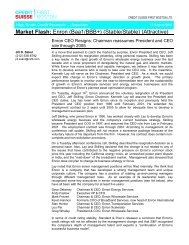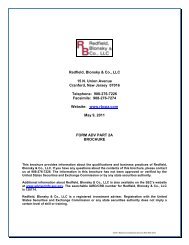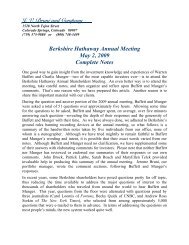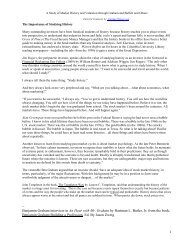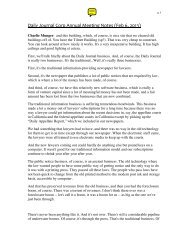Fortune Article - December 10, 2001 by Carol Loomis and interviews ...
Fortune Article - December 10, 2001 by Carol Loomis and interviews ...
Fortune Article - December 10, 2001 by Carol Loomis and interviews ...
- No tags were found...
You also want an ePaper? Increase the reach of your titles
YUMPU automatically turns print PDFs into web optimized ePapers that Google loves.
those years featured huge improvements in GNP. The business of the country grew whileinvestors' valuation of that business shrank!And then the reversal of those factors created a period during which much lower GNPgains were accompanied <strong>by</strong> a bonanza for the market. First, you got a major increase inthe rate of profitability. Second, you got an enormous drop in interest rates, which made adollar of future profit that much more valuable. Both phenomena were real <strong>and</strong> powerfulfuels for a major bull market. And in time the psychological factor I mentioned wasadded to the equation: Speculative trading exploded, simply because of the market actionthat people had seen. Later, we'll look at the pathology of this dangerous <strong>and</strong> oftrecurringmalady.Two years ago I believed the favorable fundamental trends had largely run their course.For the market to go dramatically up from where it was then would have required longterminterest rates to drop much further (which is always possible) or for there to be amajor improvement in corporate profitability (which seemed, at the time, considerablyless possible). If you take a look at a 50-year chart of after-tax profits as a percent ofgross domestic product, you find that the rate normally falls between 4%--that was itsneighborhood in the bad year of 1981, for example--<strong>and</strong> 6.5%. For the rate to go above6.5% is rare. In the very good profit years of 1999 <strong>and</strong> 2000, the rate was under 6% <strong>and</strong>this year it may well fall below 5%.So there you have my explanation of those two wildly different 17-year periods. Thequestion is, How much do those periods of the past for the market say about its future?To suggest an answer, I'd like to look back over the 20th century. As you know, this wasreally the American century. We had the advent of autos, we had aircraft, we had radio,TV, <strong>and</strong> computers. It was an incredible period. Indeed, the per capita growth in U.S.output, measured in real dollars (that is, with no impact from inflation), was abreathtaking 702%.The century included some very tough years, of course--like the Depression years of1929 to 1933. But a decade-<strong>by</strong>-decade look at per capita GNP shows somethingremarkable: As a nation, we made relatively consistent progress throughout the century.So you might think that the economic value of the U.S.--at least as measured <strong>by</strong> itssecurities markets--would have grown at a reasonably consistent pace as well.
How could this have happened? In a flourishing country in which people are focused onmaking money, how could you have had three extended <strong>and</strong> anguishing periods ofstagnation that in aggregate--leaving aside dividends--would have lost you money? Theanswer lies in the mistake that investors repeatedly make--that psychological force Imentioned above: People are habitually guided <strong>by</strong> the rear-view mirror <strong>and</strong>, for the mostpart, <strong>by</strong> the vistas immediately behind them.The first part of the century offers a vivid illustration of that myopia. In the century's first20 years, stocks normally yielded more than high-grade bonds. That relationship nowseems quaint, but it was then almost axiomatic. Stocks were known to be riskier, so whybuy them unless you were paid a premium?And then came along a 1924 book--slim <strong>and</strong> initially unheralded, but destined to movemarkets as never before--written <strong>by</strong> a man named Edgar Lawrence Smith. The book,called Common Stocks as Long Term Investments, chronicled a study Smith had done ofsecurity price movements in the 56 years ended in 1922. Smith had started off his studywith a hypothesis: Stocks would do better in times of inflation, <strong>and</strong> bonds would do betterin times of deflation. It was a perfectly reasonable hypothesis.But consider the first words in the book: "These studies are the record of a failure--thefailure of facts to sustain a preconceived theory." Smith went on: "The facts assembled,however, seemed worthy of further examination. If they would not prove what we hadhoped to have them prove, it seemed desirable to turn them loose <strong>and</strong> to follow them towhatever end they might lead."Now, there was a smart man, who did just about the hardest thing in the world to do.Charles Darwin used to say that whenever he ran into something that contradicted aconclusion he cherished, he was obliged to write the new finding down within 30minutes. Otherwise his mind would work to reject the discordant information, much asthe body rejects transplants. Man's natural inclination is to cling to his beliefs,particularly if they are reinforced <strong>by</strong> recent experience--a flaw in our makeup that bearson what happens during secular bull markets <strong>and</strong> extended periods of stagnation.To report what Edgar Lawrence Smith discovered, I will quote a legendary thinker--JohnMaynard Keynes, who in 1925 reviewed the book, there<strong>by</strong> putting it on the map. In hisreview, Keynes described "perhaps Mr. Smith's most important point ... <strong>and</strong> certainly hismost novel point. Well-managed industrial companies do not, as a rule, distribute to theshareholders the whole of their earned profits. In good years, if not in all years, theyretain a part of their profits <strong>and</strong> put them back in the business. Thus there is an element ofcompound interest (Keynes' italics) operating in favor of a sound industrial investment."It was that simple. It wasn't even news. People certainly knew that companies were notpaying out <strong>10</strong>0% of their earnings. But investors hadn't thought through the implicationsof the point. Here, though, was this guy Smith saying, "Why do stocks typicallyoutperform bonds? A major reason is that businesses retain earnings, with these going onto generate still more earnings--<strong>and</strong> dividends, too."
That finding ignited an unprecedented bull market. Galvanized <strong>by</strong> Smith's insight,investors piled into stocks, anticipating a double dip: their higher initial yield over bonds,<strong>and</strong> growth to boot. For the American public, this new underst<strong>and</strong>ing was like thediscovery of fire.But before long that same public was burned. Stocks were driven to prices that firstpushed down their yield to that on bonds <strong>and</strong> ultimately drove their yield far lower. Whathappened then should strike readers as eerily familiar: The mere fact that share priceswere rising so quickly became the main impetus for people to rush into stocks. What thefew bought for the right reason in 1925, the many bought for the wrong reason in 1929.Astutely, Keynes anticipated a perversity of this kind in his 1925 review. He wrote: "It isdangerous ... to apply to the future inductive arguments based on past experience, unlessone can distinguish the broad reasons why past experience was what it was." If you can'tdo that, he said, you may fall into the trap of expecting results in the future that willmaterialize only if conditions are exactly the same as they were in the past. The specialconditions he had in mind, of course, stemmed from the fact that Smith's study covered ahalf century during which stocks generally yielded more than high-grade bonds.The colossal miscalculation that investors made in the 1920s has recurred in one form oranother several times since. The public's monumental hangover from its stock binge ofthe 1920s lasted, as we have seen, through 1948. The country was then intrinsically farmore valuable than it had been 20 years before; dividend yields were more than doublethe yield on bonds; <strong>and</strong> yet stock prices were at less than half their 1929 peak. Theconditions that had produced Smith's wondrous results had reappeared--in spades. Butrather than seeing what was in plain sight in the late 1940s, investors were transfixed <strong>by</strong>the frightening market of the early 1930s <strong>and</strong> were avoiding re-exposure to pain.Don't think for a moment that small investors are the only ones guilty of too muchattention to the rear-view mirror. Let's look at the behavior of professionally managedpension funds in recent decades. In 1971--this was Nifty Fifty time--pension managers,feeling great about the market, put more than 90% of their net cash flow into stocks, arecord commitment at the time. And then, in a couple of years, the roof fell in <strong>and</strong> stocksgot way cheaper. So what did the pension fund managers do? They quit buying becausestocks got cheaper!• Private Pension Funds% of cash flow put into equities1971: 91% (record high)1974: 13%This is the one thing I can never underst<strong>and</strong>. To refer to a personal taste of mine, I'mgoing to buy hamburgers the rest of my life. When hamburgers go down in price, we singthe "Hallelujah Chorus" in the Buffett household. When hamburgers go up, we weep. Formost people, it's the same way with everything in life they will be buying--except stocks.
When stocks go down <strong>and</strong> you can get more for your money, people don't like themanymore.That sort of behavior is especially puzzling when engaged in <strong>by</strong> pension fund managers,who <strong>by</strong> all rights should have the longest time horizon of any investors. These managersare not going to need the money in their funds tomorrow, not next year, nor even nextdecade. So they have total freedom to sit back <strong>and</strong> relax. Since they are not operatingwith their own funds, moreover, raw greed should not distort their decisions. They shouldsimply think about what makes the most sense. Yet they behave just like rank amateurs(getting paid, though, as if they had special expertise).In 1979, when I felt stocks were a screaming buy, I wrote in an article, "Pension fundmanagers continue to make investment decisions with their eyes firmly fixed on the rearviewmirror. This generals-fighting-the-last-war approach has proved costly in the past<strong>and</strong> will likely prove equally costly this time around." That's true, I said, because "stocksnow sell at levels that should produce long-term returns far superior to bonds."Consider the circumstances in 1972, when pension fund managers were still loading upon stocks: The Dow ended the year at <strong>10</strong>20, had an average book value of 625, <strong>and</strong>earned 11% on book. Six years later, the Dow was 20% cheaper, its book value hadgained nearly 40%, <strong>and</strong> it had earned 13% on book. Or as I wrote then, "Stocks weredemonstrably cheaper in 1978 when pension fund managers wouldn't buy them than theywere in 1972, when they bought them at record rates."At the time of the article, long-term corporate bonds were yielding about 9.5%. So Iasked this seemingly obvious question: "Can better results be obtained, over 20 years,from a group of 9.5% bonds of leading American companies maturing in 1999 than froma group of Dow-type equities purchased, in aggregate, around book value <strong>and</strong> likely toearn, in aggregate, about 13% on that book value?" The question answered itself.Now, if you had read that article in 1979, you would have suffered--oh, how you wouldhave suffered!--for about three years. I was no good then at forecasting the near-termmovements of stock prices, <strong>and</strong> I'm no good now. I never have the faintest idea what thestock market is going to do in the next six months, or the next year, or the next two.But I think it is very easy to see what is likely to happen over the long term. Ben Grahamtold us why: "Though the stock market functions as a voting machine in the short run, itacts as a weighing machine in the long run." Fear <strong>and</strong> greed play important roles whenvotes are being cast, but they don't register on the scale.By my thinking, it was not hard to say that, over a 20-year period, a 9.5% bond wasn'tgoing to do as well as this disguised bond called the Dow that you could buy below par--that's book value--<strong>and</strong> that was earning 13% on par.
Let me explain what I mean <strong>by</strong> that term I slipped in there, "disguised bond." A bond, asmost of you know, comes with a certain maturity <strong>and</strong> with a string of little coupons. A6% bond, for example, pays a 3% coupon every six months.A stock, in contrast, is a financial instrument that has a claim on future distributions made<strong>by</strong> a given business, whether they are paid out as dividends or to repurchase stock or tosettle up after sale or liquidation. These payments are in effect "coupons." The set ofowners getting them will change as shareholders come <strong>and</strong> go. But the financial outcomefor the business' owners as a whole will be determined <strong>by</strong> the size <strong>and</strong> timing of thesecoupons. Estimating those particulars is what investment analysis is all about.Now, gauging the size of those "coupons" gets very difficult for individual stocks. It'seasier, though, for groups of stocks. Back in 1978, as I mentioned, we had the Dowearning 13% on its average book value of $850. The 13% could only be a benchmark, nota guarantee. Still, if you'd been willing then to invest for a period of time in stocks, youwere in effect buying a bond--at prices that in 1979 seldom inched above par--with aprincipal value of $891 <strong>and</strong> a quite possible 13% coupon on the principal.How could that not be better than a 9.5% bond? From that starting point, stocks had tooutperform bonds over the long term. That, incidentally, has been true during most of mybusiness lifetime. But as Keynes would remind us, the superiority of stocks isn'tinevitable. They own the advantage only when certain conditions prevail.Let me show you another point about the herd mentality among pension funds--a pointperhaps accentuated <strong>by</strong> a little self-interest on the part of those who oversee the funds. Inthe table below are four well-known companies--typical of many others I could haveselected--<strong>and</strong> the expected returns on their pension fund assets that they used incalculating what charge (or credit) they should make annually for pensions.Now, the higher the expectation rate that a company uses for pensions, the higher itsreported earnings will be. That's just the way that pension accounting works--<strong>and</strong> I hope,for the sake of relative brevity, that you'll just take my word for it.As the table below shows, expectations in 1975 were modest: 7% for Exxon, 6% for GE<strong>and</strong> GM, <strong>and</strong> under 5% for IBM. The oddity of these assumptions is that investors couldthen buy long-term government noncallable bonds that paid 8%. In other words, thesecompanies could have loaded up their entire portfolio with 8% no-risk bonds, but theynevertheless used lower assumptions. By 1982, as you can see, they had moved up theirassumptions a little bit, most to around 7%. But now you could buy long-termgovernments at <strong>10</strong>.4%. You could in fact have locked in that yield for decades <strong>by</strong> buyingso-called strips that guaranteed you a <strong>10</strong>.4% reinvestment rate. In effect, your idiotnephew could have managed the fund <strong>and</strong> achieved returns far higher than the investmentassumptions corporations were using.Why in the world would a company be assuming 7.5% when it could get nearly <strong>10</strong>.5% ongovernment bonds? The answer is that rear-view mirror again: Investors who'd been
through the collapse of the Nifty Fifty in the early 1970s were still feeling the pain of theperiod <strong>and</strong> were out of date in their thinking about returns. They couldn't make thenecessary mental adjustment.Now fast-forward to 2000, when we had long-term governments at 5.4%. And what werethe four companies saying in their 2000 annual reports about expectations for theirpension funds? They were using assumptions of 9.5% <strong>and</strong> even <strong>10</strong>%.I'm a sporting type, <strong>and</strong> I would love to make a large bet with the chief financial officerof any one of those four companies, or with their actuaries or auditors, that over the next15 years they will not average the rates they've postulated. Just look at the math, for onething. A fund's portfolio is very likely to be one-third bonds, on which--assuming aconservative mix of issues with an appropriate range of maturities--the fund cannot todayexpect to earn much more than 5%. It's simple to see then that the fund will need toaverage more than 11% on the two-thirds that's in stocks to earn about 9.5% overall.That's a pretty heroic assumption, particularly given the substantial investment expensesthat a typical fund incurs.Heroic assumptions do wonders, however, for the bottom line. By embracing thoseexpectation rates shown in the far right column, these companies report much higherearnings--much higher--than if they were using lower rates. And that's certainly not loston the people who set the rates. The actuaries who have roles in this game know nothingspecial about future investment returns. What they do know, however, is that their clientsdesire rates that are high. And a happy client is a continuing client.Are we talking big numbers here? Let's take a look at General Electric, the country's mostvaluable <strong>and</strong> most admired company. I'm a huge admirer myself. GE has run its pensionfund extraordinarily well for decades, <strong>and</strong> its assumptions about returns are typical of thecrowd. I use the company as an example simply because of its prominence.If we may retreat to 1982 again, GE recorded a pension charge of $570 million. Thatamount cost the company 20% of its pretax earnings. Last year GE recorded a $1.74billion pension credit. That was 9% of the company's pretax earnings. And it was 2 1/2times the appliance division's profit of $684 million. A $1.74 billion credit is simply a lotof money. Reduce that pension assumption enough <strong>and</strong> you wipe out most of the credit.GE's pension credit, <strong>and</strong> that of many another corporation, owes its existence to a rule ofthe Financial Accounting St<strong>and</strong>ards Board that went into effect in 1987. From that pointon, companies equipped with the right assumptions <strong>and</strong> getting the fund performancethey needed could start crediting pension income to their income statements. Last year,according to Goldman Sachs, 35 companies in the S&P 500 got more than <strong>10</strong>% of theirearnings from pension credits, even as, in many cases, the value of their pensioninvestments shrank.Shifting ViewsExpected pension fund returns
1975 1982 2000Exxon 7.0% 7.8% 9.5%General Electric 6.0% 7.5% 9.5%General Motors 6.0% 7.0% <strong>10</strong>.0%IBM 4.8% 5.5% <strong>10</strong>.0%Yield on long-term governmentbonds8.0% <strong>10</strong>.4% 5.5%Unfortunately, the subject of pension assumptions, critically important though it is,almost never comes up in corporate board meetings. (I myself have been on 19 boards,<strong>and</strong> I've never heard a serious discussion of this subject.) And now, of course, the needfor discussion is paramount because these assumptions that are being made, with all eyeslooking backward at the glories of the 1990s, are so extreme. I invite you to ask the CFOof a company having a large defined-benefit pension fund what adjustment would need tobe made to the company's earnings if its pension assumption was lowered to 6.5%. Andthen, if you want to be mean, ask what the company's assumptions were back in 1975when both stocks <strong>and</strong> bonds had far higher prospective returns than they do now.With <strong>2001</strong> annual reports soon to arrive, it will be interesting to see whether companieshave reduced their assumptions about future pension returns. Considering how poorreturns have been recently <strong>and</strong> the reprises that probably lie ahead, I think that anyonechoosing not to lower assumptions--CEOs, auditors, <strong>and</strong> actuaries all--is risking litigationfor misleading investors. And directors who don't question the optimism thus displayedsimply won't be doing their job.The tour we've taken through the last century proves that market irrationality of anextreme kind periodically erupts--<strong>and</strong> compellingly suggests that investors wanting to dowell had better learn how to deal with the next outbreak. What's needed is an antidote,<strong>and</strong> in my opinion that's quantification. If you quantify, you won't necessarily rise tobrilliance, but neither will you sink into craziness.On a macro basis, quantification doesn't have to be complicated at all. Below is a chart,starting almost 80 years ago <strong>and</strong> really quite fundamental in what it says. The chart showsthe market value of all publicly traded securities as a percentage of the country'sbusiness--that is, as a percentage of GNP. The ratio has certain limitations in telling youwhat you need to know. Still, it is probably the best single measure of where valuationsst<strong>and</strong> at any given moment. And as you can see, nearly two years ago the ratio rose to anunprecedented level. That should have been a very strong warning signal.For investors to gain wealth at a rate that exceeds the growth of U.S. business, thepercentage relationship line on the chart must keep going up <strong>and</strong> up. If GNP is going togrow 5% a year <strong>and</strong> you want market values to go up <strong>10</strong>%, then you need to have the linego straight off the top of the chart. That won't happen.
For me, the message of that chart is this: If the percentage relationship falls to the 70% or80% area, buying stocks is likely to work very well for you. If the ratio approaches200%--as it did in 1999 <strong>and</strong> a part of 2000--you are playing with fire. As you can see, theratio was recently 133%.Even so, that is a good-sized drop from when I was talking about the market in 1999. Iventured then that the American public should expect equity returns over the next decadeor two (with dividends included <strong>and</strong> 2% inflation assumed) of perhaps 7%. That was agross figure, not counting frictional costs, such as commissions <strong>and</strong> fees. Net, I thoughtreturns might be 6%.Today stock market "hamburgers," so to speak, are cheaper. The country's economy hasgrown <strong>and</strong> stocks are lower, which means that investors are getting more for their money.I would expect now to see long-term returns run somewhat higher, in the neighborhoodof 7% after costs. Not bad at all--that is, unless you're still deriving your expectationsfrom the 1990s.


